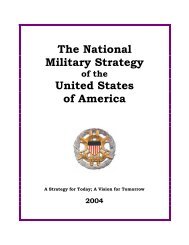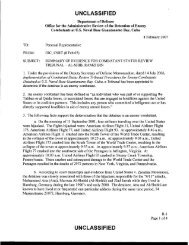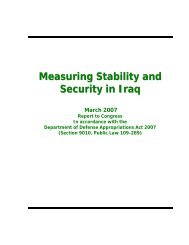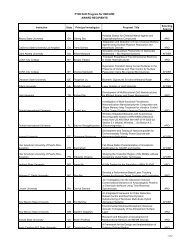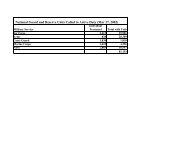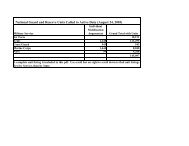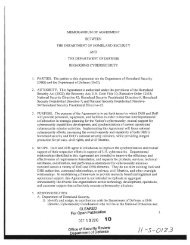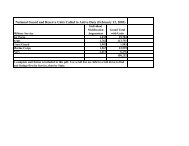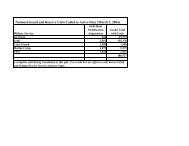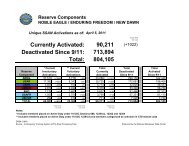Report - United States Department of Defense
Report - United States Department of Defense
Report - United States Department of Defense
You also want an ePaper? Increase the reach of your titles
YUMPU automatically turns print PDFs into web optimized ePapers that Google loves.
UNCLASSIFIED<br />
Although charged with serving as the government’s highest coordinating body for the<br />
implementation <strong>of</strong> administrative procedural reform, the High Office <strong>of</strong> Oversight and Anti-<br />
Corruption (HOOAC) remains a weak institution with few to no enforcement mechanisms.<br />
Despite persistent ISAF and U.S. Embassy engagement, the Presidential Executive Committee<br />
(PEC) on Borders, Airports and Customs Depots has yet to be fully actualized. This deficiency<br />
leaves Afghanistan with no inter-ministerial process to address significant security and economic<br />
challenges through a whole-<strong>of</strong>-government approach. Additionally, significant concerns<br />
regarding inadequate prosecution <strong>of</strong> interdicted narcotics and lethal contraband persist, resulting<br />
in continued security and economic challenges. The APPF still faces a number <strong>of</strong> potential longterm<br />
corruption and capacity issues; these could contribute to an economy driven by a few ultrarich<br />
elite and further constrain humanitarian efforts as ISAF forces redeploy.<br />
There appears to have been a modest increase in political will to tackle corruption by some<br />
senior Afghan leaders. Within the MoD and MoI, there are signs <strong>of</strong> growing political will<br />
among several key senior leaders, as evidenced by the Minister <strong>of</strong> Interior’s actions to remove<br />
corrupt police <strong>of</strong>ficers and establish “Shafafiyat Commissions” in zones and provinces, and by<br />
the MoD’s progress on the ONSC TAWG action plan.<br />
PD 45 levied anti-/counter-corruption mandates on several Afghan ministries, including the<br />
AGO and HOOAC. Unfortunately, many <strong>of</strong> the decree’s articles ordered ministries to perform<br />
actions already required by law or regulation. The decree also imposed aggressive timelines for<br />
completion <strong>of</strong> these tasks. There is an articulated general ministerial desire to meet the PD 45<br />
mandates but there has been little progress to date. Much <strong>of</strong> the progress that has been made<br />
towards meeting PD 45’s requirements has been in the form <strong>of</strong> updates given to Parliament.<br />
None <strong>of</strong> these reports has been supported by solid evidence <strong>of</strong> progress.<br />
Interagency Counter-Corruption Efforts<br />
To achieve greater unity <strong>of</strong> effort through enhanced synchronization, ISAF executed a<br />
realignment <strong>of</strong> the Civil-Military Counter Threat Network (Integrated Counter-Narcotics,<br />
Counter-Transnational Organized Crime, Counter-Threat Finance, and Counter-Terrorism<br />
Nexus) command and control (C2) construct. Counter Threat Network (CTN) commands<br />
(CJIATF-Shafafiyat, CJIATF-Nexus, Task Force 2010, assisted by the Interagency Operations<br />
Coordination Center and the Afghan Threat Finance Cell) are now nested under the newly<br />
established CJIATF-A. The synergy that will be achieved by better coordinating the execution<br />
<strong>of</strong> all CTN operations will increase the opportunity to meet the desired effects in Theater. This<br />
new construct will organize and conduct integrated Joint and Interagency Counter-Corruption<br />
operations to support ISAF strategic-effects targeting.<br />
In October 2012, CJIATF-Shafafiyat led the Counter Corruption and Organized Crime<br />
Interagency Effects Group (CCIEG) outbrief to COMISAF. The purpose <strong>of</strong> the review was to<br />
develop a common understanding among ISAF and international community partners <strong>of</strong> the level<br />
<strong>of</strong> corruption within the justice sector, with nine substantive areas being examined in detail in<br />
conjunction with Afghan justice sector subject matter experts. CJIATF Shafafiyat presented<br />
recommendations and courses <strong>of</strong> action in an attempt to diminish the impact <strong>of</strong> corruption, with<br />
144



